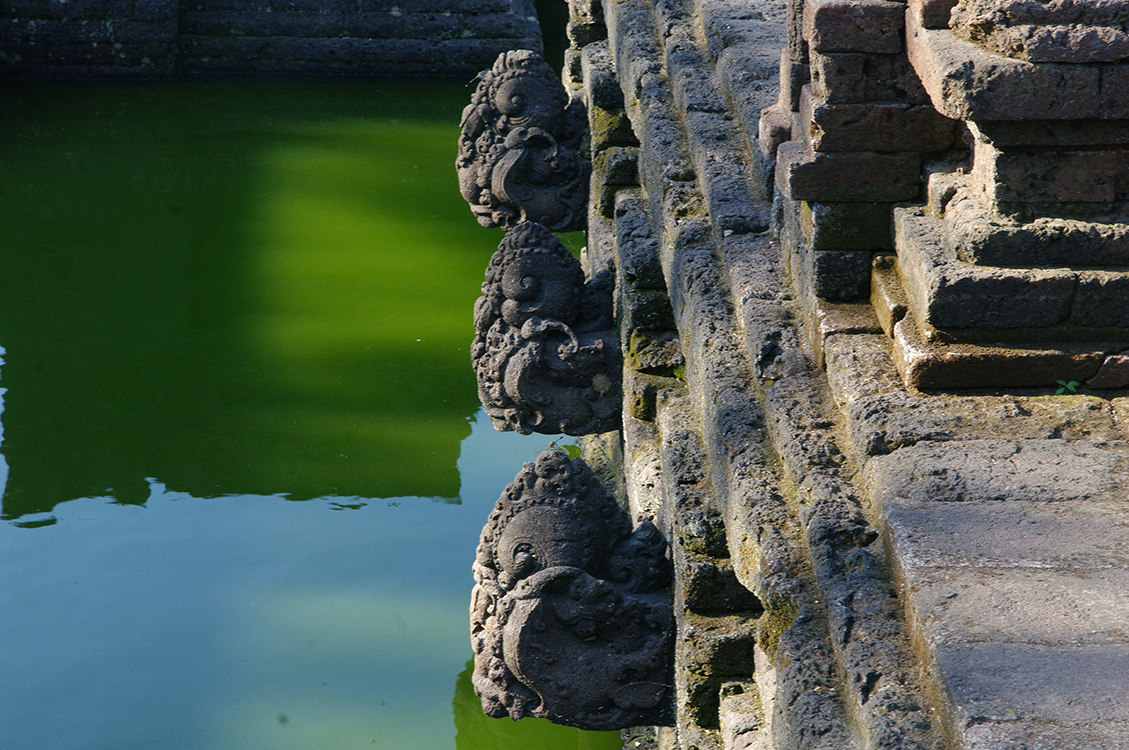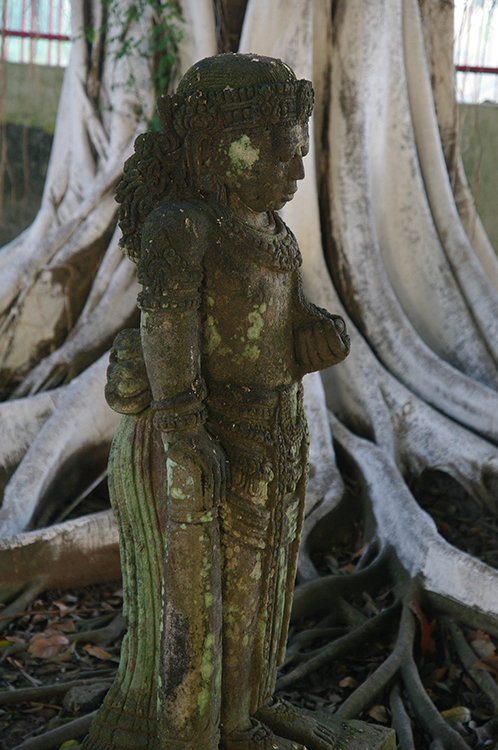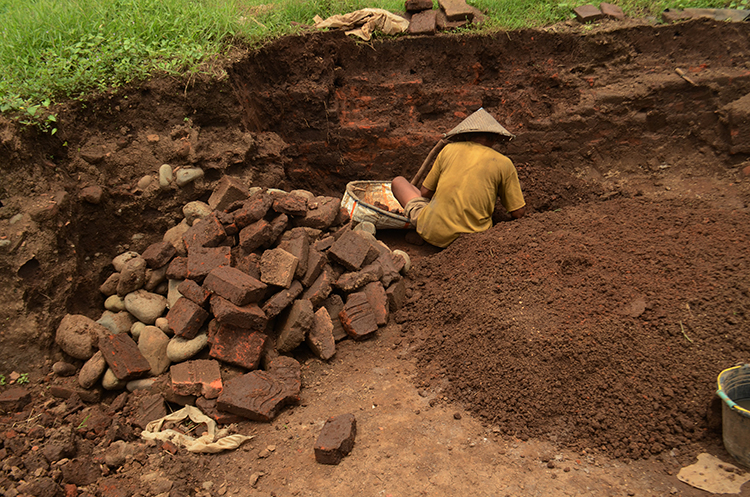Sugih Biantoro
A brick maker, Kandeg Suyanto (50), was excavating soil on his property in Trowulan on 19 July 2009 when he found an approximately 600 year-old well. After further investigations, four more wells were discovered nearby. This is not unusual in Trowulan. Local residents have recorded many historical relics belonging to the Majapahit Kingdom. Kandeg’s and others’ discoveries over hundreds of years reveal the scale and richness of Trowulan’s Majapahit heritage.
Located in the Mojokerto district, East Java, Trowulan contains royal relics of the Hindu-Buddhist Majapahit kingdom. Covering an area of about 92.6 square kilometres, these remains are the best chance of solving the riddles of the mysterious and little understood kingdom. In the 14th century, the kingdom was very influential in the archipelago. It conquered Bali, dominated Java, traded throughout Southeast Asia and Indochina, and sent missions to China. It was conquered by the Demak Islamic kingdom in 1527.
Colonial and nationalist use of the Majapahit kingdom
Back in 1815, the famous English Governor-General of the East Indies, Thomas Stamford Raffles, received a report on the discovery of the scattered ruins of buildings and temples in teak forests in remote East Java. He formed a commission to conduct a survey and J. W. B. Wardenaar (1785–1869), a former captain in the Dutch army engineers, was appointed to lead the survey. From September to October 1815, the commission mapped the remains of temples and buildings around Trowulan. Raffles’ discoveries and scientific works in Trowulan are expounded on in his masterpiece, History of Java. The Dutch government continued archaeological research at Trowulan in 1825.
 Temple Pool - Credit: Andrea Kirby (https://www.flickr.com/photos/andreakirkby/). These photos are cc licensed: Attribution-ShareAlike 2.0 Generic (CC BY-SA 2.0)
Temple Pool - Credit: Andrea Kirby (https://www.flickr.com/photos/andreakirkby/). These photos are cc licensed: Attribution-ShareAlike 2.0 Generic (CC BY-SA 2.0)
The Majapahit kingdom has long been used by nationalists as a precursor to the modern Indonesian nation. In 1934 the young nationalist Muhammad Yamin wrote an influential history of Indonesia with reference to Nagarakertagama and Majapahit. Yamin’s play, Ken Arok and Ken Dedes, included within it the statement that Indonesia is 'The Modern Majapahit'.
Conflicting land uses
Given these nationalist links, it is surprising that site preservation only began in 1986 with the government issuing a master plan (dubbed the Master Plan of Archaeology) for the development of Trowulan. The most pressing and intractable conflict is the excavation of soil for brick production. In the 1960s local people began to use old red bricks as raw material for their own brick production. Now in the site area, there are approximately 300 small red brick industries. The red brick industry came to dominate the local economy and now locals’ livelihoods are dependent on that sector. Although according to the Nagarakretagama (1365) that there are hundreds of temples built during the Majapahit Kingdom, only a small number could be saved. They have largely disappeared due to the red brick industry.
The Majapahit Information Centre controversy
In 2007 the national government started planning the Majapahit Information Centre with the aim of stimulating tourism. At that time, only one site, Troloyo’s tomb, was considered a tourism destination. The tomb is connected with the revered Islamic saints of Java, Wali Songo, and is an important destination for Muslim pilgrims. The Majapahit Information Centre was due to be completed before the presidential election in 2009, a successful information centre being a campaign opportunity for President Yudhoyono. However, the centre became the site of a national controversy because its planned location was on top of Majapahit structures. Many people, including media commentators, denounced the government as responsible for damaging important Majapahit archaeological sites. The controversy stimulated interest in Majapahit heritage across Indonesia.
The Trowulan steel factory controversy
In 2013, the local authority and the Mojokerto Cultural Heritage Preservation Office (Bali Pelestarian Cagar Budaya Mojokerto, BPCB) issued building permits to PT Manunggal Sentral Baja to build a steel factory. A new local lobby group, Save Trowulan Community, consisting mostly of local residents, protested against the government’s approval and challenged BPCB Mojokerto’s decision to recommend building a steel factory in a cultural heritage area. Unfortunately, as the Trowulan region had not been recognised as a national cultural heritage site, it lacked legal protection.
This situation has encouraged the Save Trowulan Community to petition the central government to immediately designate the Majapahit archaeological site as national cultural heritage. Save Trowulan Community was supported by social organisations working in the field of cultural heritage conservation, including the Indonesian National Trust (Badan Pelestarian Pusaka Indonesia), which raised the issue at international conferences. Due to increasing public attention, the national government formed a special team to conduct a full investigation. They concluded that the factory was within the site, so its activity should be halted. The central government revoked the building permit.
 Temple Statue - Credit: Andrea Kirby (https://www.flickr.com/photos/andreakirkby/). These photos are cc licensed: Attribution-ShareAlike 2.0 Generic (CC BY-SA 2.0)
Temple Statue - Credit: Andrea Kirby (https://www.flickr.com/photos/andreakirkby/). These photos are cc licensed: Attribution-ShareAlike 2.0 Generic (CC BY-SA 2.0)
On 30 December 2013, the minister for culture and tourism issued a decree designating Trowulan as a national cultural heritage area. The Trowulan National Cultural Heritage area occupies two sub-districts, Mojokerto and Jombang, covering 92.6 square kilometres.
Resident conflicts over Trowulan’s future
However Trowulan’s designation as a national cultural heritage area was opposed by some local residents. They argued that the designation limited economic activities, in particular securing the materials necessary for red bricks and threatened them with eviction. Those who rejected the designation also supported the construction of the steel factory and became a vocal group that clashed with the advocates for cultural heritage conservation. Meanwhile, some members of the Save Trowulan group supported other types of development at the site, such as several hotels currently being built in the area.
The steel company rejected the government’s decision and demanded a review by the Ministry of Education and Culture. They had already spent a significant sum on the initial development phases and considered the location of the steel factory as strategically important. They started a legal case against the chairman of Save Trowulan Community accusing him of libel on social media. The judicial court has not made yet any decision on the case. However these conflicts are very challenging for the preservation of Trowulan’s historical legacy, and how the site can be managed today to support local livelihoods.
Sugih Biantoro (bian_ase@yahoo.com) is a researcher at the Ministry of Education and Culture, Republic of Indonesia. His research interests are in history and cultural heritage. He is currently completing a doctorate at the University of Indonesia.
